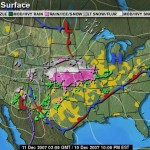 |
Archive for the ‘Severe Storm’ Category
Thursday, September 11th, 2008
Heritage Emergency National Task Force, the folks who brought us the “Emergency Response and Salvage Wheel” and lots of other helpful advice and information, has a new page up on their site called Current Disaster Information , which gathers together many resources aimed specifically at dealing with damage from hurricanes and other powerful weather events and natural disasters. The page also has a section where cultural institutions can submit damage reports and request assistance, along with the capability to view reports/requests already submitted. Also, look for the free, downloadable “Guide to Navigating FEMA and SBA Disaster Aid for Cultural Institutions,” a little farther down the page. This is a rich site, and deserves a close look at the many resources they have provided. Thanks, Heritage Emergency TF!
Posted in Core Resources, Disaster Planning, Featured Web Site, Flooding, Hazardous Weather, Hurricanes, Recovery, Severe Storm | No Comments »
Thursday, January 17th, 2008
The Mid-Atlantic region is expected to get a good dose of winter weather today. As a result, we are currently reviewing our emergency response procedures for severe weather. Below is a picture I took at 9:40am of the street that runs past our library.

Posted in Severe Storm | 1 Comment »
Tuesday, January 15th, 2008
Ready.gov is making available a wealth of information about preparation for and strategies for dealing with winter weather. They have instructions about what to do if you’re trapped in your car during a blizzard, how to recognize and begin treatment for hypothermia, a list of supplies to have on hand at home “just in case.” Winter storms are called “deceptive killers” because it is their side-effects, the peripheral damage, such as power outages and traffic accidents that cause the most deaths. The info is helpful to know even if you don’t live in a winter-weather prone area; it might come in handy if you’re travelling, plus power-outages happen everywhere and any time!
Posted in Disaster Incidents & Hazardous Weather Outlook, Featured Web Site, Hazardous Weather, Preparedness, Severe Storm | No Comments »
Tuesday, January 15th, 2008
Ready.gov is making available a wealth of information about preparation for and strategies for dealing with winter weather. They have instructions about what to do if you’re trapped in your car during a blizzard, how to recognize and begin treatment for hypothermia, a list of supplies to have on hand at home “just in case.” Winter storms are called “deceptive killers” because it is their side-effects, the peripheral damage, such as power outages and traffic accidents that cause the most deaths. The info is helpful to know even if you don’t live in a winter-weather prone area; it might come in handy if you’re travelling, plus power-outages happen everywhere and any time!
Posted in Disaster Incidents & Hazardous Weather Outlook, Featured Web Site, Hazardous Weather, Preparedness, Severe Storm | No Comments »
Monday, December 10th, 2007
The severe ice storms in the midwest are a reminder of the crippling effect ice can have on our everyday life. Are your severe weather procedures up-to-date? Can you continue to provide core services to your patrons if library staff were unable to make it to work?

Posted in Severe Storm | No Comments »
Tuesday, December 4th, 2007
For those of us who update our emergency preparedness plans with the change in seasons, we need to be thinking about the end-of-year/winter update. Probably the most significant event to consider is severe winter storms. As well as updating our work-related information, such as phone numbers and service continuity procedures in case staff don’t make it into work, we should all take a look at our own personal preparedness at home, so we don’t become casualties ourselves!

Posted in Disaster Planning, Hazardous Weather, Preparedness, Severe Storm | No Comments »
Friday, July 27th, 2007
‘Tis the season in the South!…..thunderstorms with torrential rains and strong winds, hot, muggy days that make air conditioning systems work overtime…all contribute to increased risk for leaking roofs, doorways, windows, and pipes and for flooding from blocked drains, construction sites, etc. Here are a few suggestions for catching these situations before they become catastrophes:
- conduct a daily inspection of any areas where water has come in before. Any stained ceiling tiles? Any musty smell? Any condensation build-up on exposed pipes or ductwork?
- keep an eye on the weather forecast
- ask your Facilities maintenance people to check outside drains to make sure they are clear of debris
- if you don’t know already, find out what kinds of rooms are on the floors above your space (if any) and whether they pose a threat of leaking water into your space
- replenish any disaster supplies that might be needed, such as paper towelling, rubber gloves, masks, buckets/mops
- if you don’t already have any absorbent “socks” for soaking up water off the floor, order them! (a site: New Pig)
- make sure you have current phone numbers for your response team and for the Facilities people at your institution
- know how much you can do yourself, and whom to call for back-up (commercial salvage companies, conservation organizations, etc.)
- here’s a helpful regional resource from the CCAHA listing companies that provide all sorts of materials for salvage and preservation activities: Mid-Atlantic Resource Guide for Disaster Preparedness
Posted in Disaster Incidents & Hazardous Weather Outlook, Flooding, Hazardous Weather, Preparedness, Severe Storm | No Comments »
Friday, July 27th, 2007
‘Tis the season in the South!…..thunderstorms with torrential rains and strong winds, hot, muggy days that make air conditioning systems work overtime…all contribute to increased risk for leaking roofs, doorways, windows, and pipes and for flooding from blocked drains, construction sites, etc. Here are a few suggestions for catching these situations before they become catastrophes:
- conduct a daily inspection of any areas where water has come in before. Any stained ceiling tiles? Any musty smell? Any condensation build-up on exposed pipes or ductwork?
- keep an eye on the weather forecast
- ask your Facilities maintenance people to check outside drains to make sure they are clear of debris
- if you don’t know already, find out what kinds of rooms are on the floors above your space (if any) and whether they pose a threat of leaking water into your space
- replenish any disaster supplies that might be needed, such as paper towelling, rubber gloves, masks, buckets/mops
- if you don’t already have any absorbent “socks” for soaking up water off the floor, order them! (a site: New Pig)
- make sure you have current phone numbers for your response team and for the Facilities people at your institution
- know how much you can do yourself, and whom to call for back-up (commercial salvage companies, conservation organizations, etc.)
- here’s a helpful regional resource from the CCAHA listing companies that provide all sorts of materials for salvage and preservation activities: Mid-Atlantic Resource Guide for Disaster Preparedness
Posted in Disaster Incidents & Hazardous Weather Outlook, Flooding, Hazardous Weather, Preparedness, Severe Storm | No Comments »
Monday, October 30th, 2006
Last month’s big snowstorm in Buffalo, New York, exposed some weaknesses in disaster planning. Here’s an article from the University of Buffalo addressing the issue.
Posted in Severe Storm, Suggested Readings | No Comments »
|
 |









